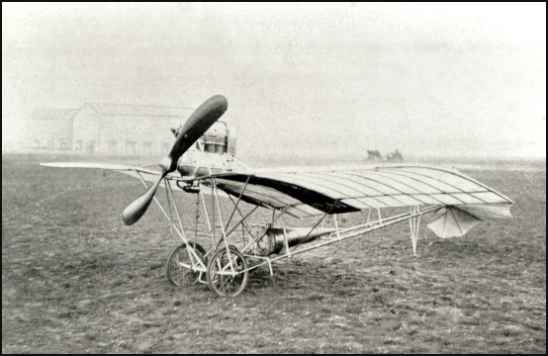
1906-1916 |
|
by Ernest Jones The machine was a box-kite structure, a pusher tailless biplane, wings at sharp dihedral, with a box elevator forward at the end of a covered fuselage. Trials of the machine had actually begun in July, suspended under his airship XIV and run along the ground, and later on its wheels without the balloon support. October 23, 1906---He flew more than 50m., though not measured. He was carried about on the shoulders of an American named Huntington. The flight was officially homologated at 23m., winning the Archdeacon Cup for the first time. |
 |
|
from a vintage postcard Collection of Roy Nagl, 12-23-05 |
 |
|
Collection of Jean-Pierre Lauwers |
|
November 12, 1906---Flew 220m., officially observed, in 21.2 secs., winning the Archdeacon Cup
and the Aero Club of France prize of 1,500 F. for the first flight of 100m. FIRST "OFFICIAL" DURATION AND DISTANCE
RECORD. ' Five other flights were made this day of 40, 40, 60, 50 and 82.6m. Two auxiliary surfaces were added to each outer cell of the machine acting as ailerons. He won the first of the 100F. prizes of the A.C.F. and was declared second holder of Archdeacon Cup by his flight of 82.6m. in 7.2 secs. The entire world heralded these flights. Made before officials of the Aero Club de France, newspaper correspondents and other witnesses, they stirred up renewed effort everywhere, and attracted attention to the earlier and infinitely greater flights of the Wrights. |
 |
|
Collection of Jean-Pierre Lauwers |
 |
|
Collection of Jean-Pierre Lauwers |
 |
|
Collection of Jean-Pierre Lauwers |
|
The winter was spent in building a new machine, though his next flight was at St. Cyr, on April 4,
1907, 50m., in the XIV-bis of 1906. Trials went on at same time with the new machine XV (Antoinette 100), a headless biplane with sharp dihedral in wings like XIV-bis, a tractor this time, with elevators on outer forward corners of dihedral main planes of wood instead of fabric, biplane tail enclosing two vertical panels. The tail acted as both elevator and rudder, being mounted on a universal joint at the end of bamboo outriggers. No flights appear to have been made, though trials began March 22, 1907. |
 |
|
Collection of Jean-Pierre Lauwers |
|
The next Dumont airplane was the XIX, the famous Demoiselle, a baby tractor
monoplane with two-cylinder opposed air-cooled Dutheil-Chalmers engine of 17-20 h.p., with elevator forward just ahead of the chassis
on a level with the axle. The wings had a sharp dihedral angle. Vertical lozenge-shaped panel on each side of chassis and a universally
mounted cruciform tail. November 16, 1907---With this machine were made flights of 200m., 100m. and 200m. at Issy on November 17, among others. March 1908---Experiments were made with Dumont's sixteenth aircraft, a machine with two engines of low power. October 1908---A new Demoiselle was flown at Issy similar to above but with forward elevator omitted and with an Antoinette 24 h.p. engine. In November it was flown at St. Cyr. Flights were continued at various times through 1909, including the FIRST CROSS-COUNTRY flight one of about eight kils., from St. Cyr to Buc on September 13, returning the following day, and another on the seventeenth, of 18 kils. in 16 mins. Dumont's name was not thereafter prominently connectied with aeronautics. The Demoiselle, fitted with two-cylinder engine, became rather popular. It was flown by Audemar and Roland Garros at the Belmont Park, New York, meet in 1910 and facsimiles and parts therefor were sold by American supply concerns for several years thereafter. |
 |
|
|
 |
SANTOS-DUMONT non va ricordato solo per la progettazione a costruzione dei suoi nove dirigibili, tutti differenti, ma anche per due biplani a tre monoplani. Famoso è il suo No. 14bis, biplano di lunghezza m. 10, apertura alare m. 12, peso Kg. 160, motore Levasseur da 50 HP, che il 23.10.1906 decolla e atterra con i propri mezzi compiendo un volo di 60 m., il fatto è eccezionale perché siamo al tempo in cui altri pionieri usano catapulte per il decollo. Il 1907 è l'anno del DEMOISELLE un elegante monoplano con cui Santos-Dumont compie il (primo volo tra due città da Saint-Cyr a Buc con il record di velocità di 95 Km/h. |
The SANTOS-DUMONT no. 6, on October 19, 1901, flew from Parc de Saint Cloud to the Eiffel Tower and returned in 30 minutes, winning the Deutsch prize of 100.000 in French goldwhich the great pioneer donated to the poor of Paris. SANTOS-DUMONT is not only remembered for the planning and construction of his nine airships, all different, but also for two biplanes and three monoplanes. The most famous is his 14bis, a biplane 10 meters in length, with a wing span of 12 meters, a weight of 160 Kg. and powered by a 50 hp Levasseur motor. On October 23, 1906, it took off and landed under its own power, travelling a distance of 60 meters. It made an exceptional flight at a time when other pioneers had to use catapults for the takeoff. 1907 was the year of the DEMOISELLE, an elegant monoplane in which Santos-Dumont completed the first flight between two cities, from Saint-Cyr to Buc, at record speed of 95 Km/h. |


|